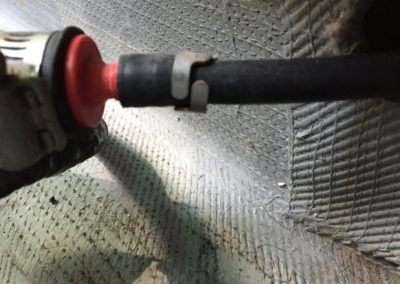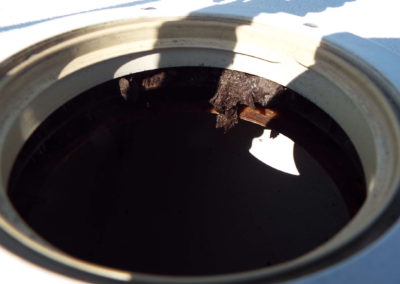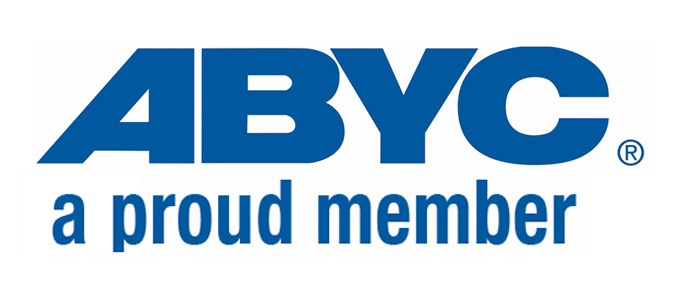

Osmotic Blister on Sailboat Hull
Osmotic Blisters on an early 1980’s sloop. These happened to be dry although there were others on this hull that were weeping and in need of attention. The larger blister here is about the size of a quarter and the smaller a dime. The blister is caused by a reaction of the underlying FRP (fiberglass reinforced plastic) and the water that ultimately seeps through the porous gelcoat. These two combine to form a solution usually with styrene that expands and loosens the gelcoat to form the blister. Blisters do not condemn a hull although they often do require attention.
Gasoline fuel primer bulb with loose fuel hose
The gasoline fuel line on this boat is attached to the primer bulb while the clamp securing the hose to the primer bulb barb fitting is not positioned properly. The spring clamp is positioned too far away from the primer bulb and does not securely hold the hose on the barb fitting as the clamp is not positioned to squeeze the hone onto the barb. This is almost worse than not having any clamp at all because the spring clamp in this situation will slowly squeeze the hose pulling it further off the barb fitting. Repair before vessel is next under way!
Lobster boat -diesel wet exhaust hose damage
Marine Pre-Purchase Survey Inspection reveals a bulging wet exhaust hose on a commercial lobster boat. The hose has suffered damage from heat and age and needs to be replaced. You can see in the center of the picture that there is a rupture in the outer cover of this hose-for that to be there, underlying layers of hose have also ruptured and the gas pressure from the exhaust is causing the bulge. This hose is located beneath the pilothouse, if ruptured both exhaust gas and water would be expelled inside the vessel.
Parker Racor 500 water in diesel fuel
Racor 500 Series water separator/fuel filter. This filter is mounted in the engine room of a lobster boat and is the only source of filtration for the 220Hp diesel engine in this boat. As you can see there is a significant amount of water that has accumulated in the bowl and the vacuum gauge is reading 6 or 7inHG at idle. It is certainly time to drain that water and change the filter! Also missing from this filter is the metal heat shield at the bottom of the bowl to allow this filter to pass a 2.5 minute fire test and not allow any fuel to spill per ABYC Standards.
Broken bond wire on stuffing box
It is clear to see that the bonding wire has corroded and detached from its lug mounted to the stuffing box on this sailboat. The bonding system protects the vessel from stray current corrosion of underwater appendages. By connecting the underwater appendages to a zinc sacrificial anode the anode takes the brunt of the corrosion degradation saving the crucial through hulls, propellers, shafts, and prop struts. The bonding system inside the boat has the same effect as the zincs that you put on the trim tabs, and propeller shafts, protection of stray current corrosion. Also in this picture it is quite apparent that it is time to replace the hose clamps on the packing gland. Most likely the majority of damage you see here was caused by an improperly adjusted packing gland that was spraying salt water around the compartment while under way.
Stainless steel chainplate crevice corrosion
This chain plate has suffered crevice corrosion and is in jeopardy of complete failure. This damage, unnoticed by the vessel owner compromised the attachment of the split backstay on a rig that stands over 75 feet to the transom. Often this type of staining in the gelcoat is indicative of crevice corrosion that is attacking the oxygen deprived stainless steel that is out of sight. Stainless steel is by nature corrosion resistant due to the addition of chromium although when immersed in salt water and deprived of oxygen it loses this characteristic. If you look closely you can see the longitudinal fracture in this chain plate.
Rotten wood core on Luhrs 32 foredeck
This pie plate hatch is on the foredeck of a sportfishing boat that had a windlass installed which lacked proper access to the anchor locker. This access hatch was added to assist in flaking anchor rode below if needed. You can see in the top of the hatch the decaying wood core as well as the inside skin of the fiberglass laminate. This damage was isolated to approximately 4″ surrounding the screw out type hatch and could have easily been prevented by sealing the wood core after the hole for the hatch was cut. A very common problem that has turned into a costly repair.
Regulator 26 bait well hose without clamp
This photo is of the scupper drain on a Regulator 26′ Center Console. The deck is to the left and the excess rain or splash water runs through the horizontal oval fiberglass to the right and exits the vessel. There is a hinged flapper outside the hull to prevent backflow when in a following sea or backing the vessel down. Here you can see the 3/4″ hose from a livewell attached to the top of the scupper missing the hose clamp. As it stands- there is potential for an open 3/4″ hole into this vessel approximately 3″ above the waterline if this hose comes off the barb fitting.










